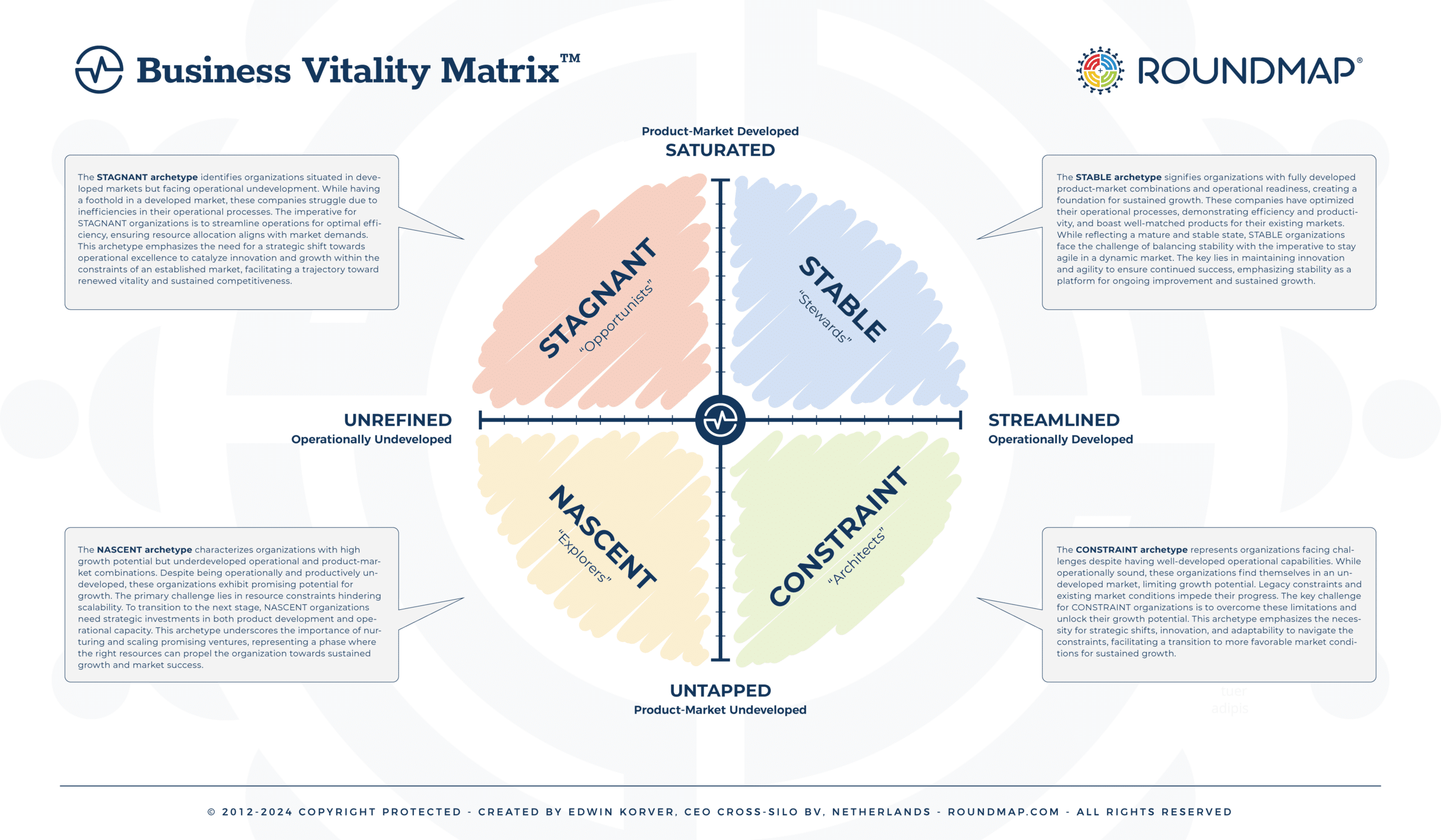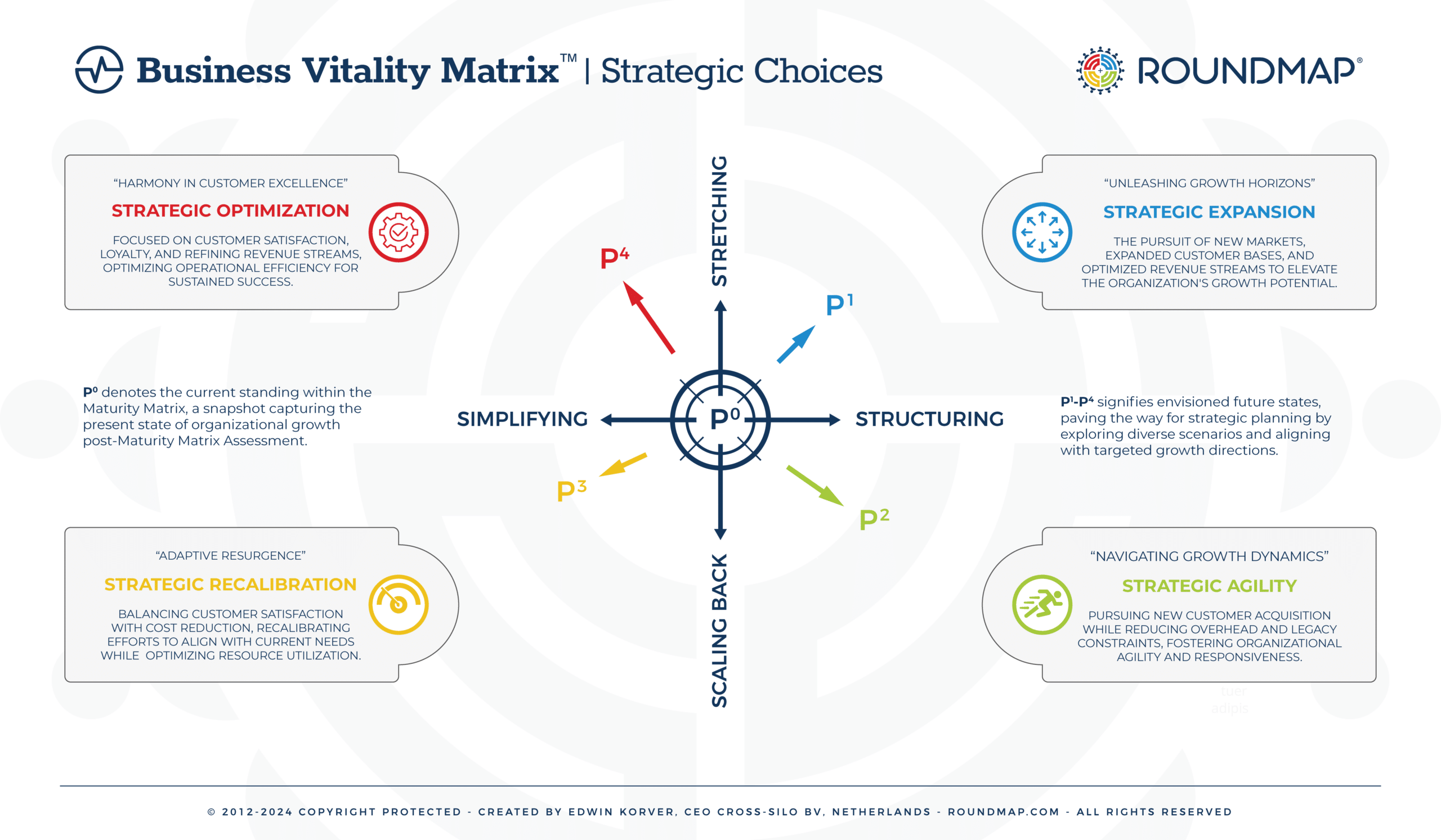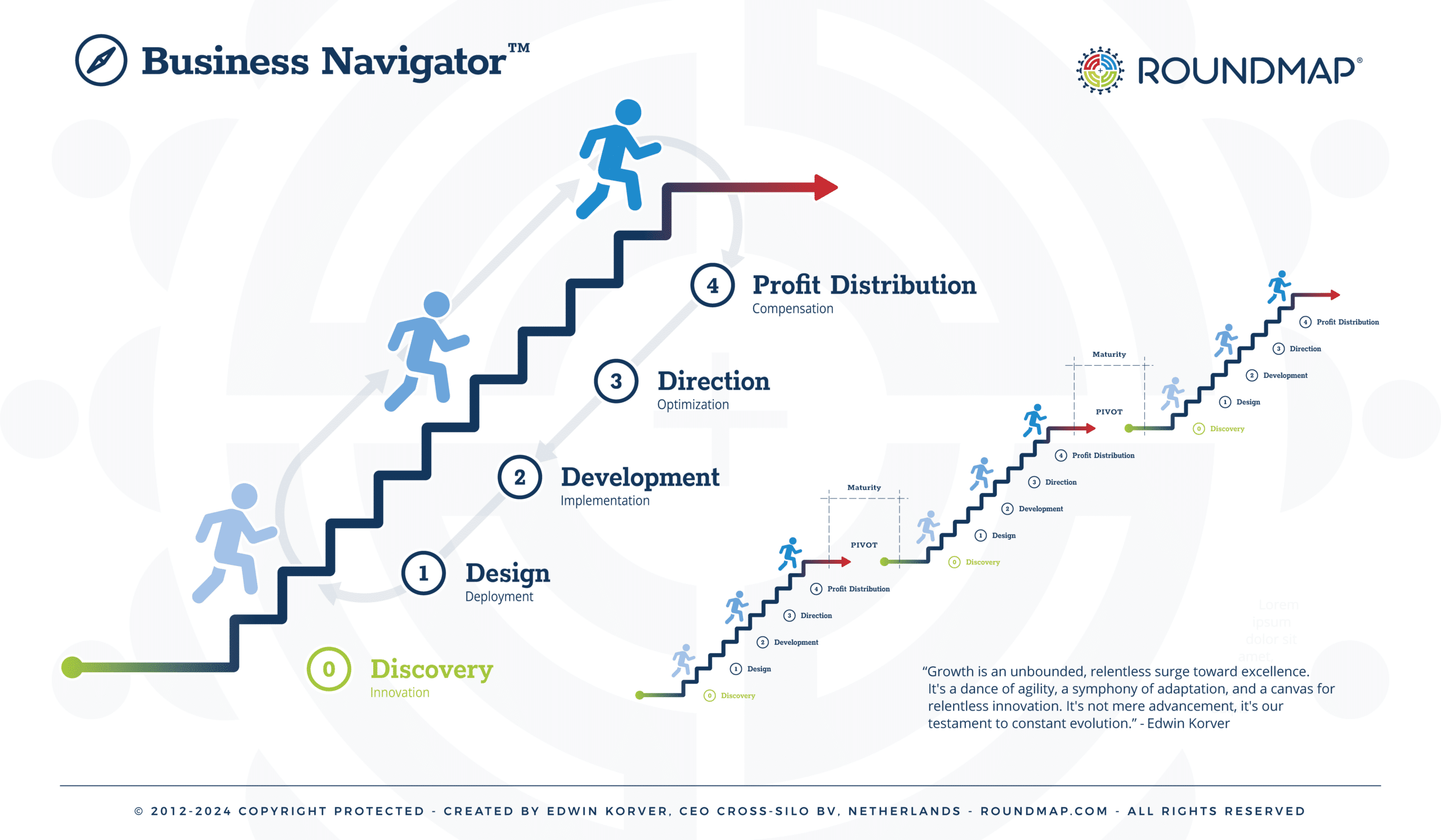“True business vitality is the art of harmonizing excellence with impact; it’s about nurturing a growth that is as meaningful as it is measurable. It’s not just about scaling up, but scaling with purpose, where every stride in excellence leaves a lasting, positive imprint on the world.” ~Edwin Korver, Architect RoundMapLet’s explore the strategic archetypes within the matrix, each offering a unique lens into your organization’s current state and potential pathways for growth:
- Nascent State: Uncover untapped potential in operationally and productively undeveloped organizations, awaiting the resources needed to scale.
- Stagnant State: Navigate through operationally undeveloped organizations in developed markets, highlighting opportunities to streamline operations for heightened efficiency.
- Constraint State: Explore organizations with developed operations in undeveloped markets, identifying strategies to overcome legacy challenges and unlock growth potential.
- Stable State: Delve into fully developed organizations, both operationally and productively, uncovering insights to enhance agility for faster adaptation to market dynamics.
The product-market combination is on a scale of 1 to 10: 1: Latent – Representing an early, dormant stage with minimal presence. 2-4: Nascent – Signifying varying degrees of early development. 5-7: Emerging – Indicating active development and progress. 8-9: Maturing – Reflecting advanced stages of development. 10: Discontinuing – Denoting the cessation or discontinuation of the entity being assessed.
Exploring the Archetypes of the Business Vitality Matrix
In the intricate tapestry of organizational growth, understanding where your company stands is pivotal for strategic navigation. The following insights unravel the distinctive characteristics of the four archetypes within the Business Vitality Matrix™: Nascent, Stagnant, Constraint, and Stable State. Each archetype paints a unique portrait, offering a lens through which to assess your organization’s current state and chart a course for future success. Let’s explore the defining traits of each archetype, providing a compass for informed decision-making on your journey toward sustained growth and resilience.
Nascent State Companies in the Vitality Matrix:
Product-Market Combination: Nascent state companies display promising signs of potential in their product-market combination. While their products or services showcase innovation, they may still lack widespread market validation. This stage is characterized by the early cultivation of ideas, products, or services, with the potential for growth if provided with the right resources and market recognition.
Operational Readiness: Operational readiness in nascent companies is limited, marked by a lack of comprehensive operational capabilities and resources. These organizations possess the potential for scalability but require additional resources to fully realize it. The focus here is on building a foundation for operational excellence that aligns with the innovative products or services being offered.
Challenges: Nascent state companies face a dual challenge, necessitating investment in both product development and operational capacity. The risk of resource constraints looms, potentially hindering their growth trajectory. Striking a balance between refining their innovative offerings and strengthening operational capabilities becomes crucial at this stage, setting the tone for their journey toward maturity. The challenges present opportunities for strategic investment and development to position themselves for sustainable growth.
"Short-term evidence aside, any marketing strategy that focuses solely on quick sales wins is myopic in nature. Notably, conversion-dominated strategies stand in opposition to numerous academic studies that argue that upper-funnel marketing is the best path to growth. When it comes to customer acquisition, the Ehrenberg-Bass Institute argues that building awareness is the best way to attract new customers—the primary ingredient in long-term viability."
Nielsen, 2023 (Long-Term Business Vitality Should Outweigh Short-Term Sales Gains) Tweet
Stagnant State Companies in the Vitality Matrix
Product-Market Combination: Stagnant state companies find their products or services well-suited for a developed market. However, they face challenges such as market saturation or heightened competition, imposing limitations on their potential growth. This stage calls for strategic considerations to navigate mature markets and seek avenues for differentiation.
Operational Readiness: Operational readiness in stagnant companies is characterized by inefficiencies or a lack of optimization. Resources may not be fully utilized or streamlined, resulting in operational bottlenecks. This phase requires a critical evaluation of internal processes and resource allocation to enhance efficiency and competitiveness.
Challenges: Stagnant state companies encounter challenges that demand strategic operational improvements. There is a pressing need to explore untapped market segments or inject innovation into their offerings to revitalize growth. This stage prompts a reevaluation of their operational landscape, urging them to adapt to changing market dynamics and unlock new avenues for expansion and competitiveness.
Constraint State Companies in the Vitality Matrix
Product-Market Combination: Constraint state companies find their products or services well-suited for an undeveloped market. However, they grapple with challenges such as limited market demand or obstacles in market development. This stage requires a strategic approach to navigate and stimulate growth within the constraints of an evolving market.
Operational Readiness: Operational readiness in constrained companies is marked by well-established capabilities but faces challenges rooted in legacy systems. The presence of legacy processes or systems may hinder adaptability and responsiveness to market changes. This phase demands a delicate balance between leveraging established operational strengths and overcoming legacy constraints.
Challenges: Constraint state companies confront the challenge of overcoming legacy constraints to unlock their full growth potential. Strategic shifts and innovation are imperative to address market challenges and ensure that operational readiness aligns with the evolving demands of the market. This stage encourages a proactive approach to modernization and strategic innovation, paving the way for sustained growth in an ever-changing landscape.
Stable State Companies in the Vitality Matrix
Product-Market Combination: Stable state companies boast well-matched products or services for the existing market. They have established a robust customer base and market presence, aligning their offerings with market needs. This stage signifies a level of maturity where products are well-received, contributing to the stability of the business.
Operational Readiness: Operational readiness in stable companies is characterized by efficient and optimized processes. These organizations have adequate resources and demonstrate agility in responding to market changes. The focus is on maintaining operational excellence, ensuring that resources are effectively utilized, and responses to market shifts are swift and strategic.
Challenges: Stable state companies face the challenge of balancing stability with the need for continuous improvement. While their current operations are efficient, they must strive to maintain innovation and agility to respond to evolving market dynamics. This phase encourages a forward-thinking approach, fostering a culture of innovation and adaptability to sustain stability and thrive in a dynamic business environment.
Comparing Fitness, Vitality, and Maturity
Our vitality approach centers on the dynamic interplay between adaptability, innovation, and strategic foresight. To explain the differences, let’s consider fitness, vitality, and maturity from an operational standpoint:
- Operational Fitness:
- Focus: Immediate capability to perform day-to-day operations efficiently and effectively.
- Emphasis: Current operational health, agility, and responsiveness.
- Time Horizon: Short-term focus on meeting current operational demands.
- Characteristics: Involves aspects like process efficiency, supply chain responsiveness, and adaptability to changes in the business environment.
- Operational Maturity:
- Focus: Overall evolution and development of operational processes and capabilities over time.
- Emphasis: Long-term sustainability, learning, and improvement of operational performance.
- Time Horizon: Extended time frame considering the organization’s growth and adaptation over the long term.
- Characteristics: Involves the ability to learn from experiences, implement best practices, and continually enhance operational processes.
- Operational Vitality:
- Focus: The dynamic and adaptive capacity of operations to thrive in a constantly changing environment.
- Emphasis: The organization’s ability to anticipate and proactively respond to emerging challenges and opportunities.
- Time Horizon: Balances both short-term agility and long-term strategic adaptation.
- Characteristics: Involves a focus on innovation, resilience, and the capacity to navigate uncertainties. Operational vitality goes beyond immediate fitness to encompass sustained adaptability and innovation.
In summary, while operational fitness concentrates on the immediate capability to meet current demands, operational maturity looks at the long-term evolution of processes. In contrast, operational vitality places emphasis on the dynamic and adaptive capacity of operations. Operational vitality incorporates both short-term agility and long-term strategic adaptation, with a focus on innovation, resilience, and the ability to thrive in a constantly changing business environment. Vitality, therefore, goes to the readiness toward future growth realization. Organizations aiming for operational excellence often seek a balance between fitness, maturity, and vitality to navigate the complexities of the contemporary business landscape.
Navigating Business Vitality: A Dual Framework for Revenue and Operations
In the intricate journey from one archetype (or state) to the other, the strategic pathway unfolds through the dynamic interplay of Stretching, Structuring, Scaling Back, and Simplifying:
- Stretching: ‘Stretching’ embodies a relentless focus on customer growth, an expression of the revenue model within the business framework. It signifies reaching new markets, expanding customer bases, and optimizing revenue streams—essentially stretching the boundaries of what the business can achieve.
- Structuring: Conversely, ‘Structuring’ emphasizes building the organization, an expression of the operating model. This involves meticulous organizational fortification, optimizing internal processes, and enhancing operational efficiency. ‘Structuring’ recognizes the significance of establishing a robust foundation for sustainable growth, ensuring that the organization can withstand the demands of an evolving landscape.
- Scaling Back: At the same time, the strategic journey acknowledges the necessity for flexibility and adaptability. Enter ‘Scaling Back,’ a deliberate reevaluation of growth efforts to avoid overextension and foster a more balanced approach. ‘Scaling Back’ prompts a recalibration, ensuring that growth is purposeful and aligned with the organization’s capabilities.
- Simplifying: Similarly, ‘Simplifying’ becomes a vital companion to ‘Structuring,’ representing a deliberate move towards reducing bureaucracy, enhancing flexibility, and dismantling unnecessary layers. This shift allows the organization to operate with agility, fostering a culture of innovation and responsiveness.
These dimensions, like the instruments of an orchestra, harmonize in unique combinations, giving rise to distinct strategic directions that guide the journey from the current state to the future state. Let’s delve into each dimension’s strategic play, revealing the nuanced symphony of actions that shape both revenue and operating models, fostering a holistic approach to organizational advancement.
Four Strategic Directions

STRATEGIC EXPANSION (Stretching & Structuring):
- Revenue Model: Focus on customer growth, market expansion, and revenue optimization.
- Operating Model: Meticulous organizational fortification, process optimization, and enhanced operational efficiency to support growth.

STRATEGIC AGILITY (Structuring & Scaling Back):
- Revenue Model: Pursuing new customer acquisition while strategically reducing overhead and legacy constraints.
- Operating Model: Building organizational structure while scaling back non-essential elements, fostering agility and responsiveness.
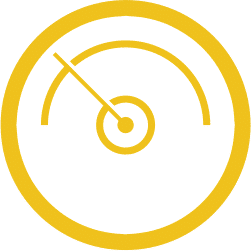
STRATEGIC RECALIBRATION (Simplifying & Scaling Back):
- Revenue Model: Balancing customer satisfaction and cost reduction, with a focus on recalibrating efforts.
- Operating Model: Simplifying processes and scaling back activities to adapt to current customer needs while optimizing resource utilization.
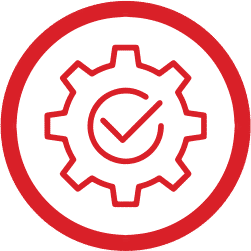
STRATEGIC OPTIMIZATION (Stretching & Simplifying):
- Revenue Model: Sustained focus on customer satisfaction, loyalty, and revenue stream refinement.
- Operating Model: Streamlining processes, reducing complexities, and enhancing customer experiences for optimal operational efficiency.
In the 1960s, BCG’s founder, Bruce Henderson, said that bigness is a big idea. High relative market share yields lower costs, which generate more cash to fund growth, creating a virtuous cycle of sustained competitive advantage. But size no longer means what it used to: today, only 7% of companies that are market share leaders are also profit leaders in their industries—down from 25% in the 1960s. Scale is thus increasingly an indication of past success, not a predictor of future performance.
McKinsey, 2015 (Tomorrow Never Dies: The Art of Staying on Top)
Incorporating the Business Navigator
When juxtaposed with the Business Navigator™, a strategic framework that delineates the structural aspects of an organization’s growth, the Business Vitality Matrix™ reveals a deliberate staircase-like progression. This strategic alignment is not arbitrary but rooted in the principles advocated by Steve Blank’s Customer Development Theory, emphasizing the simultaneous co-development of products, customers, and organizational capabilities.
Drawing inspiration from this theory, the prescribed path for evolving from a nascent startup into a sustainable growth machine follows a calculated sequence. It involves a systematic ascent – taking one step up through strategic customer acquisition, followed by a lateral move – taking one step to the side by investing in building robust organizational capabilities. This iterative process is designed to be cyclic, fostering a continuous loop of development and adaptation.
In essence, this staircase-like growth trajectory underscores the importance of a balanced and synchronized approach, ensuring that customer acquisition and product development are harmoniously complemented by the concurrent enhancement of organizational capabilities. Such a strategic cadence resonates with the dynamic nature of business evolution, offering a pragmatic roadmap for startups aiming not just for growth but for sustainable and resilient expansion over time.
Declining vitality is making large companies increasingly vulnerable to change, according to our research. A 2015 BCG study, for example, found that just 7% of companies that are market share leaders in their industries are also profit leaders. Many are merely hanging on. Loss of vitality stems in part from the natural life cycle of companies: The high growth rates typical of younger companies are hard to sustain. But in the long run, the majority of returns for shareholders are driven by revenue growth. For companies to prosper and deliver for investors well past the startup stage, they must learn the secrets of staying vital.
Martin Reeves, Senior Partner at BCG and Director of the BCG Henderson Institute Tweet
What the BCG Matrix Fails to Identify
The BCG Matrix, a widely used strategic planning tool, empowers businesses to scrutinize their product portfolio, pinpoint growth opportunities, and align strategies with product market share and growth rates. However, it inherently lacks consideration for the organizational readiness crucial for unlocking the full potential of identified growth opportunities.
In stark contrast, the Business Vitality Matrix goes beyond, offering a holistic perspective by incorporating both product-market dynamics and the operational ‘fitness’ of the firm. This comprehensive approach allows businesses to not only assess growth potential in a given product-market fit but also evaluate it in the context of the organization’s overall readiness to capitalize on such potential.
Consider a startup focused solely on customer acquisition without concurrently building a robust management system. This myopic approach might lead to a critical roadblock when faced with customer pushback. Conversely, if the startup prioritizes developing a capable management system over immediate customer acquisition, it risks missing a crucial window of opportunity. Striking the right balance becomes paramount.
Similarly, established yet stagnant incumbents seeking innovation may find their formal structures and entrenched procedures hindering the process. Here, opting for the lean startup route, with a willingness to iterate and integrate later, becomes a strategic choice to navigate the complexities of transformation and foster innovation within a rigid framework.
Inspiration for the Business Vitality Matrix
The idea for the Vitality Matrix originated in 2021 when much was said and written about achieving product-market fit. But what about the company’s capabilities to seize these growth opportunities, Edwin Korver asked himself? What about the product-company or the market-company fit? These seem very relevant questions. So, he wrote an article about it.
Furthermore, as he contemplated business health in 2018, he created four Sustainable Health Monitors™: market health, customer health, operational health, and organizational health, aligning with the Business Vitality Matrix.
Interestingly, BCG’s work on Corporate Vitality was unknown to Edwin Korver, the architect of RoundMap, until late November 2023. After years of study, the concept of Business Vitality emerged, synthesizing his way up from the frontline operation to the top of the business enterprise. Both models consider operational maturity, but the BCG model focuses on the potential for financial growth. In contrast, our Vitality Matrix considers the potential for achieving excellence. This is because we believe growth means better, and better can lead to more.
Set in perspective: BCG is a $12 billion revenue, 25,000-employee organization. We are a David amongst Goliaths.

